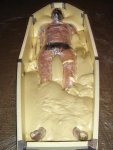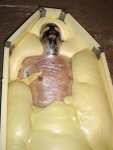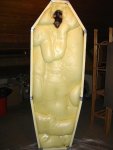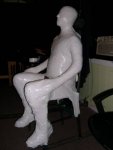I found another encasement to be considered. It's easier and less expensive than fiberglass. As mentioned before, cement is heavy and takes a long time to dry. I suggest a modified version of body casting. That process uses a latex inner layer to capture the fine details of the body part being copied and is covered by a plaster cast for rigidity. For the purpose of entombment, I suggest the latex be left out and a modified version of the casting method be used.
First of all, I would obtain a plaster called Quick-Set from a home improvement store. It is a powder and has to be mixed with water as it is used. I would use gauze or a very loose woven cloth for reinforcement. Quick-Set sets up in a matter of minutes and dries harder than regular Plaster of Paris. The most important part of using it is to keeping it from sticking to the skin which can be achieved with a liberal application of petroleum jelly and plastic wrap over the hair and any body openings. A large straw or tube should be used and plastic or goggles should cover the eye because plaster must not contact mucous membranes.
To begin, one needs to carefully lay out everything that will be needed for the process because it sets up fast. It's important to have a tub or bucket of clean water and clean rags available to clean off any plaster the gets directly on skin and to wear disposable latex gloves and eye protection while working. Decide what pose you want to create and rehearse it with your subject. Then cover the subject with the petroleum jelly and plastic. If desired, the subject could be entirely wrapped in plastic.
Mix the Quick-Set in small batches because it can only be worked for ten to fifteen minutes. Saturate the gauze in the plaster and start at the highest point and work your way down. Apply it by wrapping strips across each other and smooth with with gloved hands. If you dip your hands in water while working, the outcome will be smoother. Apply two to three layers to one area leaving edge pieces to overlap the next area. After fifteen minutes, dispose of any leftover plaster and start a new batch.
I suggest that the subject stand in a tub of cool water while being worked on because the Quick-Set can warm up while setting. Don't let the subject overheat. Work one area at a time, overlapping strips. Having more than one worker can get the job done faster. Once the subject is covered, let the plaster dry for about twenty minutes or so. I don't recommend sanding it as the dust is unhealthy. But you can touch up a little with the plaster mix that has been thinned. The casting should be well stiffened in an hour and dry after a few hours.
It will hold up for years. Keep in mind that Quick-Set dries quite hard. To remove it, crack the plaster with a small hammer, cut the gauze with shears and gently pull it off. Use soapy water to detach adhesions. If the subject is to remain entombed for a long period of time, you might want to provide holes for feeding and relieving. I think it would be fun to do this to someone.




